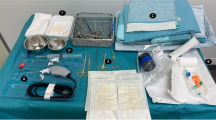Abstract
Purpose
Studies have shown that isolated tenotomy of the long head of the biceps (LHB) improves significantly pain scores, active range of motion and Constant score in elderly patients with massive and irreparable cuff tears with no osteoarthritis. This cadaveric study was performed to assess the feasibility of a tenotomy of the LHB and subacromial corticosteroid injection using a minimally invasive in-office setting under local anaesthesia on awake patients.
Materials and methods
Twenty scare-free shoulders were included in the study. We performed the procedure in an in-office setting using a wrist arthroscope with no fluid, connected to wireless camera and light source. A standard shoulder arthroscopy was finally performed in order to analyse the tenotomy quality and detect possible iatrogenic lesions.
Results
The LHB tendon was cut fully in all cases, the mean length of the proximal stump of the LHB was 0.4 cm (range, 0.3–0.7 mm) and the mean duration of the surgery was 3.5 minutes (range, 2.43–3.86 min). No iatrogenic lesion occurred during the in-office procedure.
Conclusion
This cadaveric study suggests that it is feasible and safe to perform, under local anaesthesia, a minimally invasive arthroscopic tenotomy of the LHB and subacromial injection using an in-office setting. Further clinical studies are needed to confirm the reliability, indication and effectiveness of this technique.



Similar content being viewed by others
References
Szabó I, Boileau P, Walch G (2008) The proximal biceps as a pain generator and results of tenotomy. Sports Med Arthrosc. https://doi.org/10.1097/JSA.0b013e3181824f1e
Meeks BD, Meeks NM, Froehle AW et al (2017) Patient satisfaction after biceps tenotomy. Orthop J Sport Med 5:232596711770773. https://doi.org/10.1177/2325967117707737
Walch G, Edwards TB, Boulahia A et al (2005) Arthroscopic tenotomy of the long head of the biceps in the treatment of rotator cuff tears: clinical and radiographic results of 307 cases. J Shoulder Elb Surg. https://doi.org/10.1016/j.jse.2004.07.008
Wu P-T, Jou I-M, Yang C-C et al (2014) The severity of the long head biceps tendinopathy in patients with chronic rotator cuff tears: macroscopic versus microscopic results. J Shoulder Elb Surg 23:1099–1106. https://doi.org/10.1016/j.jse.2013.11.013
Ahrens PM, Boileau P (2007) The long head of biceps and associated tendinopathy. J Bone Jt Surg - Br. https://doi.org/10.1302/0301-620X.89B8.19278
Maynou C, Mehdi N, Cassagnaud X et al (2005) Clinical results of arthroscopic tenotomy of the long head of the biceps brachii in full thickness tears of the rotator cuff without repair: 40 cases. Rev Chir Orthop Reparatrice Appar Mot. https://doi.org/10.1016/s0035-1040(05)84327-2
Galdi B, Southren DL, Brabston EW et al (2016) Patients have strong preferences and perceptions for biceps tenotomy versus tenodesis. Arthrosc J Arthrosc Relat Surg 32:2444–2450. https://doi.org/10.1016/j.arthro.2016.04.022
Rol M, Favard L, Berhouet J (2018) Diagnosis of long head of biceps tendinopathy in rotator cuff tear patients: correlation of imaging and arthroscopy data. Int Orthop 42:1347–1355. https://doi.org/10.1007/s00264-017-3616-x
Castricini R, Familiari F, De Gori M et al (2018) Tenodesis is not superior to tenotomy in the treatment of the long head of biceps tendon lesions. Knee Surg Sport Traumatol Arthrosc 26:169–175. https://doi.org/10.1007/s00167-017-4609-4
Kerschbaum M, Maziak N, Scheuermann M, Scheibel M (2017) Arthroskopische Tenodese oder Tenotomie der langen Bizepssehne bei vorselektionierten Patienten. Orthopade 46:215–221. https://doi.org/10.1007/s00132-016-3358-2
Hsu AR, Ghodadra NS, Provencher CMT et al (2011) Biceps tenotomy versus tenodesis: a review of clinical outcomes and biomechanical results. J Shoulder Elb Surg 20:326–332. https://doi.org/10.1016/j.jse.2010.08.019
Boileau P, Baqué F, Valerio L et al (2007) Isolated arthroscopic biceps tenotomy or tenodesis improves symptoms in patients with massive irreparable rotator cuff tears. J Bone Jt Surg - Ser A. https://doi.org/10.2106/JBJS.E.01097
Pander P, Sierevelt IN, Pecasse GABM, van Noort A (2018) Irreparable rotator cuff tears: long-term follow-up, five to ten years, of arthroscopic debridement and tenotomy of the long head of the biceps. Int Orthop 42:2633–2638. https://doi.org/10.1007/s00264-018-3991-y
Greditzer HG, Kaplan LD, Lesniak BP, Jose J (2014) Ultrasound-guided percutaneous long head of the biceps tenotomy: a novel technique with case report. HSS J. https://doi.org/10.1007/s11420-014-9397-5
Atlan F, Werthel JD (2016) Ultrasound-guided intra-articular tenotomy of the long head of the biceps: a cadaveric feasibility study. Int Orthop 40:2567–2573. https://doi.org/10.1007/s00264-016-3231-2
Lévy B, Ducat A, Gaudin P et al (2012) Ultrasound-guided percutaneous tenotomy of the long head of the biceps tendon: a non-reliable technique. Knee Surg Sport Traumatol Arthrosc. https://doi.org/10.1007/s00167-011-1671-1
Cheng NM, Pan WR, Vally F et al (2010) The arterial supply of the long head of biceps tendon: anatomical study with implications for tendon rupture. Clin Anat. https://doi.org/10.1002/ca.20992
Andrin J, Pottecher P, Viard B et al (2017) Linear relationship between lateralization of the bicipital groove and humeral retroversion and its link with the biepicondylar humeral line. Anatomical study of seventy cadaveric humerus scans. Int Orthop 41(7):1431–1434. https://doi.org/10.1007/s00264-017-3495-1
Boileau P, Ahrens PM, Hatzidakis AM (2004) Entrapment of the long head of the biceps tendon: the hourglass biceps--a cause of pain and locking of the shoulder. J Shoulder Elb Surg 13(3):249–257. https://doi.org/10.1016/S1058274604000187
Author information
Authors and Affiliations
Corresponding author
Ethics declarations
Conflict of interest
The authors declare that they have no conflict of interest.
Ethical approval
All procedures performed in studies involving human participants were in accordance with the ethical standards of the institutional and national research committee and with the 1964 Helsinki declaration and its later amendments or comparable ethical standards. For this type of study formal consent is not required.
Additional information
Publisher’s note
Springer Nature remains neutral with regard to jurisdictional claims in published maps and institutional affiliations.
Rights and permissions
About this article
Cite this article
Popescu, IA., Teboul, F., Goubier, JN. et al. In-office shoulder arthroscopy and tenotomy of the long head of the biceps tendon—a cadaveric feasibility study. International Orthopaedics (SICOT) 43, 2361–2365 (2019). https://doi.org/10.1007/s00264-019-04377-z
Received:
Accepted:
Published:
Issue Date:
DOI: https://doi.org/10.1007/s00264-019-04377-z




